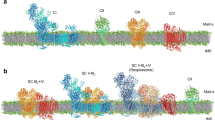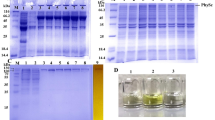Abstract
Transcriptional repressor Bach1 plays an important role in antioxidant response. Bach1 function is regulated by heme binding to the four cysteine-proline (CP) motifs in Bach1, which leads to inhibition of its activity. Three of these CP motifs are located N-terminal to the bZip (basic leucine zipper) domain that is responsible for DNA binding. Based on sequence analysis, the region surrounding these CP motifs was expected to be intrinsically disordered. Bach1 is one of few known intrinsically disordered proteins that accept multiple heme molecules for functional regulation, but the molecular mechanisms of heme binding and functional regulation remain unclear. Uncovering these mechanisms is important for understanding Bach1-mediated antioxidant response. Biophysical characterization revealed that 5-coordinated heme binding was unique to the CP motifs within the heme-binding region of Bach1, whereas 6-coordinated binding occurred nonspecifically. Comparison of the wild-type protein and a CP motif mutant indicated that the level of 6-coordinated heme binding was reduced in the absence of 5-coordinated heme binding. Analytical ultracentrifugation showed that the CP motif mutant protein had a more elongated conformation than the wild-type protein, suggesting that cysteines within the CP motifs contribute to intramolecular interactions in Bach1. Thus, heme binding at the CP motifs induces a global conformational change in the Bach1 heme-binding region, and this conformational change, in turn, regulates the biological activity of Bach1.






Similar content being viewed by others
Abbreviations
- IPTG:
-
Isopropyl β-d-1-thiogalactopyranoside
- DTT:
-
Dithiothreitol
- TCEP:
-
Tris(2-carboxyethyl)phosphine
- MALDI-TOF MS:
-
Matrix-assisted laser desorption/ionization time-of-flight mass spectrometry
- NMR:
-
Nuclear magnetic resonance
- NOESY:
-
Nuclear Overhauser effect spectroscopy
- TOCSY:
-
Total correlation spectroscopy
References
Alam J et al (2000) Mechanism of heme oxygenase-1 gene activation by cadmium in MCF-7 mammary epithelial cells: role of p38 kinase and Nrf2 transcription factor. J Biol Chem 275:27694–27702. https://doi.org/10.1074/jbc.M004729200
Brewitz HH et al (2015) Role of the chemical environment beyond the coordination site: structural insight into Fe(III) protoporphyrin binding to cysteine-based heme-regulatory protein motifs. ChemBioChem 16:2216–2224. https://doi.org/10.1002/cbic.201500331
Buchan DW, Minneci F, Nugent TC, Bryson K, Jones DT (2013) Scalable web services for the PSIPRED protein analysis workbench. Nucleic Acids Res 41:W349–W357. https://doi.org/10.1093/nar/gkt381
Delaglio F, Grzesiek S, Vuister GW, Zhu G, Pfeifer J, Bax A (1995) NMRPipe: a multidimensional spectral processing system based on UNIX pipes. J Biomol NMR 6:277–293
Dyson HJ (2016) Making sense of intrinsically disordered proteins. Biophys J 110:1013–1016. https://doi.org/10.1016/j.bpj.2016.01.030
Erickson HP (2009) Size and shape of protein molecules at the nanometer level determined by sedimentation, gel filtration, and electron microscopy. Biol Proc Online 11:32–51. https://doi.org/10.1007/s12575-009-9008-x
Hira S, Tomita T, Matsui T, Igarashi K, Ikeda-Saito M (2007) Bach1, a heme-dependent transcription factor, reveals presence of multiple heme binding sites with distinct coordination structure. IUBMB Life 59:542–551. https://doi.org/10.1080/15216540701225941
Igarashi K, Kurosaki T, Roychoudhuri R (2017) BACH transcription factors in innate and adaptive immunity. Nat Rev Immunol 17:437–450. https://doi.org/10.1038/nri.2017.26
Igarashi K, Watanabe-Matsui M (2014) Wearing red for signaling: the heme-bach axis in heme metabolism, oxidative stress response and iron immunology. Tohoku J Exp Med 232:229–253
Iida A, Inagaki K, Miyazaki A, Yonemori F, Ito E, Igarashi K (2009) Bach1 deficiency ameliorates hepatic injury in a mouse model. Tohoku J Exp Med 217:223–229
Ito N, Watanabe-Matsui M, Igarashi K, Murayama K (2009) Crystal structure of the Bach1 BTB domain and its regulation of homodimerization. Genes Cells 14:167–178. https://doi.org/10.1111/j.1365-2443.2008.01259.x
Kuhl T et al (2013) Analysis of Fe(III) heme binding to cysteine-containing heme-regulatory motifs in proteins. ACS Chem Biol 8:1785–1793. https://doi.org/10.1021/cb400317x
Laue TM, Shah BD, Ridgeway TM, Pelletier SL (1992) Computer-aided interpretation of analytical sedimentation data for proteins. In: Harding SE, Rowe AJ, Horton JC (eds) Analytical uiltacentrifugation in biochemistry and polymer science. Royal Society of Chemistry, Cambridge, pp 90–125
Levitt M (1978) Conformational preferences of amino acids in globular proteins. Biochemistry 17:4277–4285
Manon F, Ebel C (2010) Analytical Ultracentrifugation, a useful tool to probe intrinsically disordered proteins. In: Longhi S, Uversky V (Eds) Instrumental analysis of intrinsically disordered proteins: assessing structure and conformation. Wileys, New York, pp 433–449
Mazmanian K, Sargsyan K, Grauffel C, Dudev T, Lim C (2016) Preferred hydrogen-bonding partners of cysteine: implications for regulating Cys functions. J Phys Chem B 120:10288–10296. https://doi.org/10.1021/acs.jpcb.6b08109
Muto A et al (2004) The transcriptional programme of antibody class switching involves the repressor Bach2. Nature 429:566–571. https://doi.org/10.1038/nature02596
Ogawa K et al (2001) Heme mediates derepression of Maf recognition element through direct binding to transcription repressor Bach1. EMBO J 20:2835–2843. https://doi.org/10.1093/emboj/20.11.2835
Oyake T et al (1996) Bach proteins belong to a novel family of BTB-basic leucine zipper transcription factors that interact with MafK and regulate transcription through the NF-E2 site. Mol Cell Biol 16:6083–6095
Roychoudhuri R et al (2013) BACH2 represses effector programs to stabilize T(reg)-mediated immune homeostasis. Nature 498:506–510. https://doi.org/10.1038/nature12199
Schuck P (2000) Size-distribution analysis of macromolecules by sedimentation velocity ultracentrifugation and lamm equation modeling. Biophys J 78:1606–1619. https://doi.org/10.1016/S0006-3495(00)76713-0
Sun J et al (2002) Hemoprotein Bach1 regulates enhancer availability of heme oxygenase-1 gene. EMBO J 21:5216–5224
Suzuki H et al (2004) Heme regulates gene expression by triggering Crm1-dependent nuclear export of Bach1. EMBO J 23:2544–2553. https://doi.org/10.1038/sj.emboj.7600248
Tanimoto T et al (2009) Genetic ablation of the Bach1 gene reduces hyperoxic lung injury in mice: role of IL-6. Free Radical Biol Med 46:1119–1126. https://doi.org/10.1016/j.freeradbiomed.2009.01.017
Tompa P (2002) Intrinsically unstructured proteins. Trends Biochem Sci 27:527–533
Uversky VN (2002) What does it mean to be natively unfolded? Eur J Biochem 269:2–12
Watanabe-Matsui M et al (2011) Heme regulates B-cell differentiation, antibody class switch, and heme oxygenase-1 expression in B cells as a ligand of Bach2. Blood 117:5438–5448. https://doi.org/10.1182/blood-2010-07-296483
Watanabe-Matsui M, Matsumoto T, Matsui T, Ikeda-Saito M, Muto A, Murayama K, Igarashi K (2015) Heme binds to an intrinsically disordered region of Bach2 and alters its conformation. Arch Biochem Biophys 565:25–31. https://doi.org/10.1016/j.abb.2014.11.005
Yano Y et al (2006) Genetic ablation of the transcription repressor Bach1 leads to myocardial protection against ischemia/reperfusion in mice. Genes Cells 11:791–803. https://doi.org/10.1111/j.1365-2443.2006.00979.x
Yoshida C et al (1999) Long range interaction of cis-DNA elements mediated by architectural transcription factor Bach1. Genes Cells 4:643–655
Zenke-Kawasaki Y et al (2007) Heme induces ubiquitination and degradation of the transcription factor Bach1. Mol Cell Biol 27:6962–6971. https://doi.org/10.1128/MCB.02415-06
Acknowledgements
We acknowledge the support of the Biomedical Research Core of the Tohoku University Graduate School of Medicine. This work was supported by a JSPS Grant-in-Aid for Scientific Research Number 18H04021 and 15H02506 (KI) and Research Fellowships for Young Scientists (Grant No. 16J40189) to M. W.-M. We thank Natasha Beeton-Kempen, Ph.D., from Edanz Group (www.edanzediting.com/ac) for editing a draft of this manuscript.
Author information
Authors and Affiliations
Corresponding author
Ethics declarations
Conflict of interest
KI and KM received partial financial support from Teijin Pharma Co., Ltd. through a collaborative research contract.
Additional information
Publisher's Note
Springer Nature remains neutral with regard to jurisdictional claims in published maps and institutional affiliations.
Electronic supplementary material
Below is the link to the electronic supplementary material.
Rights and permissions
About this article
Cite this article
Segawa, K., Watanabe-Matsui, M., Tsuda, K. et al. Biophysical characterization of heme binding to the intrinsically disordered region of Bach1. Eur Biophys J 48, 361–369 (2019). https://doi.org/10.1007/s00249-019-01364-5
Received:
Revised:
Accepted:
Published:
Issue Date:
DOI: https://doi.org/10.1007/s00249-019-01364-5




